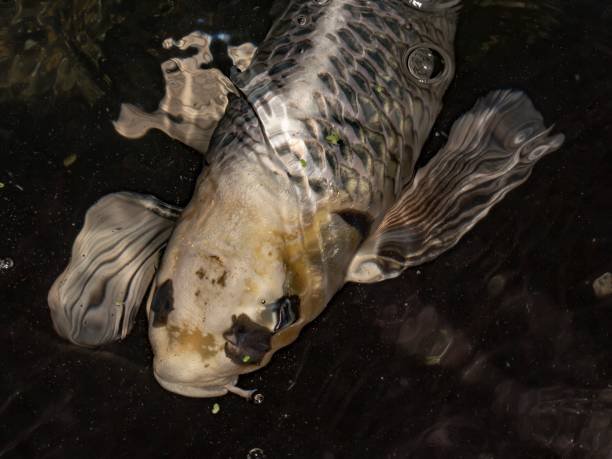Skin Disorders in fishes
I am guessing you never thought that fishes could develop a skin disorder, well if you've always thought that, this post is here to correct that notion
Welcome to skin disorders in fishes
Let's dig in
Fish, one of the approximately 34,000 species of vertebrates (phylum chordata) found in the fresh and salt waters of the world. Living species range from the primitive jawless lampreys and hagfish, to the cartilaginous sharks, rays to the abundant and diverse bony fish. Most species of fish are cold-blooded; However, one species, the opah (Lampris guttatus), is warm-blooded.
The term fish is applied to a variety of vertebrates from different lineages of evolution. Describes a life form rather than a taxonomic group.As members of the phylum Chordata, fish share certain characteristics with other vertebrates. These features are gill slits at some point in the life cycle, a notochord or skeletal support rod, a hollow dorsal nerve cord, and a tail.
Many of the disorders and diseases known to affect fish are the result of stress, poor water quality, overcrowding and a failure to quarantine new or diseased fish to prevent the spread of disease. All of these factors can be minimized with proper care and good hygiene. Infections by bacteria, protozoa, viruses, fungi or parasites can also occur.
Many different skin problems can occur in the aquarium. Fortunately, they can be diagnosed and treated with careful daily observation. Inspect your fish carefully each day, looking for abnormal growth, changes to the fish's body, or damage to scales, fins, or body covering. Check for parasites and monitor swimming behaviour to see if their habits have changed. A daily visual diagnosis is paramount to the health and happiness of your fish friends.The most common skin diseases are white spot disease, velvet disease, parasitic infestations, eye diseases, mouth fungus, fungus, anchorworm, fish lice, peptic ulcer disease, sepsis and stress.
Let's take a look at them in turn:

Image of a diseased fish by sonya kate wilson
Furunculosis : Its caused by infection with Aeromonas Salmonicida, subspecies Salmonicida, which can cause bacterial septicemia in salmonids. The term furunculosis derives from the bump-like lesions on the skin and muscles of infected fish. In chronic infections, fish show lethargy, anorexia, pale gills, and darkening of the skin, although these clinical signs are also reported for other bacterial septicemias. The most recognizable clinical signs of the disease are hemorrhagic erosions of the fins and tail, skin hemorrhages and skin ulcers. Edwardsiellosis is generally described as a systemic disease, but mild infections in channel catfish have been reported to manifest as small skin lesions
located on the posterolateral surfaces of the body.An opportunistic bacterial disease of the skin and fins of all freshwater and occasionally marine fish.White Spot Disease: Look for visible spots on the skin. Ichtyophtirius, or white spot disease, presents as separate, distinct spots.
Velvet disease: are the spots numerous and powdery in appearance? Is your fish the freshwater type? If so, the fish is likely suffering from Oodinium limneticum, or velvet disease.
If parts of the skin are excessively mucous and this mucus is cloudy and covers most of the fish's body, then suspect a parasite infestation. They are generally attacked by one of three different parasites: Costia, Chilodonella, or Trichodina.
If the mucus listed in number three only covers the eye, an eye disease is suspected, usually caused by improper handling and poor water conditions.
If there is mucus around the mouth, which appears as very short, bushy, fine threads, then your fish most likely has mouth fungus.
If the slime on the fish's body is fibrous and has a cotton-like appearance, then suspect a fungus.
If a parasite is visible and worm-like, then your problem is probably the anchor worm.
Again, if a parasite is visible and round, suspect fish lice.
If an ulcer is seen on the body of the fish, suspect an ulcer caused by bacteria and may indicate the fish is suffering from blood poisoning.
If the skin is red and appears dull, the likelihood of sepsis is high. Septicemia is a bacterial disease and a serious threat to your fish.
If the same conditions exist with a long-finned, cold-water fish, you may have a fish that has experienced sudden changes in water conditions, such as e.g. rapidly rising or falling temperatures and PH values.
With careful observation, you can quickly identify and diagnose skin diseases in your aquarium. Remember, if you are unable to diagnose, consult a veterinarian who specializes in fish diseases
Remember!!! "A river, an ocean is honoured for its fish, not its size" so let take proper care of our fishes, with this I say👇
Thanks for reading see you in my next post @sam9999
References/Resources
Reference 1
Reference 2
Reference 3
Reference 4
Reference 5
Reference 6

https://twitter.com/sam999916/status/1541132821074481152
The rewards earned on this comment will go directly to the people( @sam9999 ) sharing the post on Twitter as long as they are registered with @poshtoken. Sign up at https://hiveposh.com.